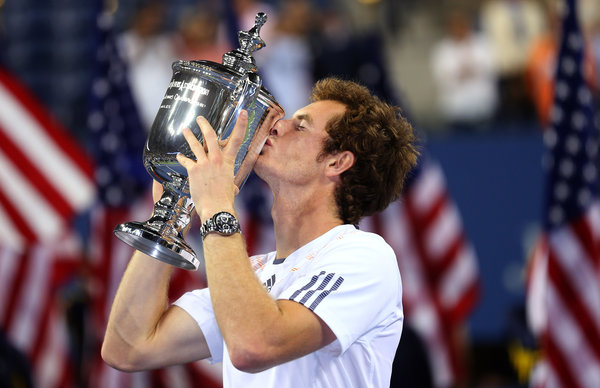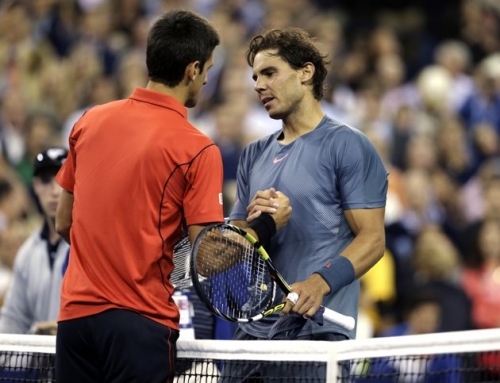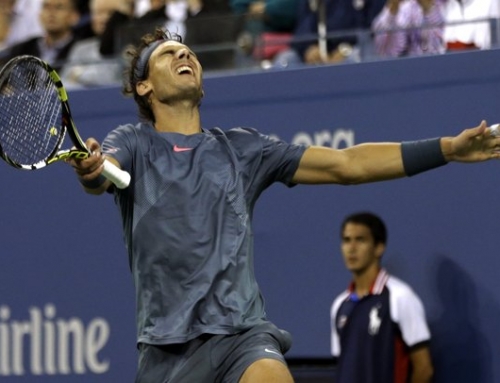Before World War 2.
76 years.
That was the last time a British male won a singles Slam is so long ago that the world was a different place then. No cell phones, no computers. Plane travel was a rarity. Players would take boat trips to play Slams at other venues. People worried about diseases.
Ever since then, the British have hoped. In the 1980s, they had John Lloyd. He was only ever good enough to play well at far-flung places like the Australian Open when few played there any more. Then, there was Tim Henman. He was not the top 5 player like Andy Murray. He may have overachieved reaching 4 Wimbledon semis, then, in a surprise, in 2004, he reached the semis of the US Open and the French Open. Gentleman Tim broke the hearts of many a British fan who wished he was just a bit better.
With Andy Murray, Britain finally had someone talented enough to contend for Slams. Murray had reached 3 Slam finals by the start of 2012. He reached the finals of the US Open back in 2008 upsetting Rafael Nadal in the semis for the first time. That would also turn out to be the first of five consecutive years that the US Open would be held on a Monday night.
The second time came at the Australian Open in 2010. That year, Murray’s rank had slipped enough that he came into the Australian Open as the fifth seed and had the bad luck to be put into Nadal’s quarter. They met in the quarterfinal and Murray played great tennis. However, Nadal was injured and chose to retire. Murray had to work hard to beat Cilic in the semis, and then lost in straight sets to Roger Federer.
That was the first sign of a complaint with Murray’s style. Back in 2008, it was understandable that, in his first Slam, Murray would be nervous. Federer makes it tough on first-timers as he beat Novak Djokovic the year before. But the second time around, Murray had a head-to-head lead over Federer. Federer had been having on-and-off years between 2008 and 2010. He was shanking forehands, and so the thinking was you could beat him if you played enough shots. He would miss, and you could win.
While that theory works great in smaller events where Federer may care less about the title, Federer is a different player in the finals of a Slam where he’s often hit his stride, making shots he would miss in a smaller event.
Murray tried to outrally Federer in long backhand rallies. Federer was hitting his backhand great that tournament. It would slide later that year, and wouldn’t come back until late 2011/early 2012.
By 2011 Australian Open, Murray had been expecting to play Federer in the finals again, after he beat David Ferrer who beat Nadal in the quarterfinals when Nadal got injured for a second year in a row. He might have been better prepared to play Federer than Novak Djokovic.
Little would Murray know that Novak Djokovic would start an amazing year where he wouldn’t lose until the French Open semis, and then go on to win Wimbledon and the US Open. Murray was far more ready to play Federer than Djokovic, so he struggled against someone that was just so much steadier than he had been prior to that year.
Even so, Murray was criticized again for his play. He was said to be too passive. Although he had added some power to his game, it would only appear every once in a while, say, when he was playing Nadal or Federer. Indeed, in all remaining three semis that Murray reached in 2011, he lost each one to Nadal who always seemed steadier, able to expose Murray’s inconsistencies.
In late 2011, Murray announced that he and Ivan Lendl would pair up. Lendl had famously lost his first four Slam finals, despite ushering in a new age of tennis. He brought the power forehand and the power serve and showed you could dominate from the baseline. Although he was the first to really have a modern power game, it was nothing like today’s game where winners come fast and furious. Lendl still had to play long rallies to win points.
Lendl had been away from tennis for nearly a decade and a half suffering from the problem that forced him to retire from tennis: a bad back. It didn’t stop him from playing golf, however. Lendl finally found a doctor that could treat his back, and he came back to play some senior tour. Once he could travel, then the possibility that he would coach came into play.
Murray had had his share of coaches. He was with Brad Gilbert, but like pretty much everyone who has worked with Gilbert since Agassi, the relationship just didn’t work out. Gilbert was just too intense, wanted to be in his client’s life, and they argued. Prior to 2008, Murray paired up with Miles MacLagan and hired a group of people to help him get in much better shape. Murray had played well against top players but faded badly in matches where fitness mattered.
Murray would then add a consultant in Alex Corretja. Murray had traditionally done poorly on clay. His flatter style and finesse was not well-suited to the grinding style needed to succeed on clay. Corretja had been a French Open finalist. Murray like Corretja for another reason: his Slam credentials. He had never won a Slam, but he had gotten a lot closer than Maclagan.
Maclagan forced the issue wondering if his opinions mattered. The two decided to part amicably, and Murray decided to also let Corretja go. He went without a coach for a while. Unofficially, it seemed like Judy Murray, his mom, and his hitting buddy, Dani Vallverdu, who had trained with him in Spain as a teenager were his coaches. Andy Murray made it known that he wanted a coach with experience, preferably Slam experience.
Such coaches were, of course, few and far between. There had been some discussion that Darren Cahill, who coached Agassi and who had been approached by Federer, might be interested, but he backed out.
When Lendl’s name came up, there were many things that seemed right about the choice. Lendl was known as a meticulous player, someone who looked at diet, training, and did things that were seen as strange in his day, but is now seen as the way modern players prepare. Lendl switched racquets after every ball change. He trained with up-and-coming juniors. He had his court in New Haven laid by those that laid the US Open courts.
Everyone thought Lendl’s intensity might butt heads with Andy Murray, but Lendl decided to give Murray his space. He agreed to be with him at Slams, but he also wanted his tee time to play the game he loves.
Despite only having worked a few weeks, Murray reached the semis of the Australian Open in 2012, and pushed Djokovic to 5 sets. Surprisingly, Djokovic played an equally intense match in the final to win the first Slam of the year. Some felt Lendl’s influence was already positive.
Murray would reach his first Wimbledon final, and earn his first set in a Slam final. Federer would come back and play aggressive and claim yet another Wimbledon title. But Murray would turn around, get his game focused once again, and take the Olympic gold, topping Djokovic and Federer along the way. It certainly didn’t hurt that Nadal, who lost early at Wimbledon, decided he couldn’t play the Olympics nor the US Open because Nadal had given Murray such grief.
Four years earlier, Murray had lost in the opening round of the Beijing Olympics. Immediately, he regretted he didn’t take that more seriously, though the early loss let him return back to the US and make his best run in any Slam ever. Murray knew that there would be only one shot at him trying to win the Olympic gold on home soil, and the win seemed to raise Murray’s spirits.
Murray would head over to Toronto win a match, then retire in the following match before rains delayed matches. He would go to Cincy and also win a match, then lose one. Murray had, in 2009 and 2010, lost early at the US Open, the Slam he thought he’d win first. He blamed this on peaking a bit too soon. Due to the Olympics, Murray was unable to train in Miami where he normally builds up his conditioning for the heat.
Murray would reach the final in shaky situation. He struggled to hold serve against Bogomolov, despite breaking him numerous times. He cleaned up his play against Ivan Dodig. He dropped a set against Feliciano Lopez in the heat, and managed to get across the finish line, then he played dominant tennis to beat Milos Raonic. He looked down and out against Marin Cilic, almost down two sets to love, but clawed his way to a second set, and managed to hang on for a four set win. He dealt with very windy conditions against Tomas Berdych who very nearly pushed him to a fifth set before Murray came back at the end to win the fourth set tiebreak.
Djokovic had a much easier route to the finals, struggling only against David Ferrer in the wind, before coming back the next day to easily win in four sets.
The day of the final was a cool, yet windy final. The question was how Murray would choose to play Djokovic. Murray was probably not ready to outhit Djokovic who had shown he could absorb a lot of pace in his match against del Potro.
Murray opted for a peculiar strategy. He chose to play a lot of balls up the middle, and not provide a lot of pace. He want to keep points very long, and hope that fitness would eventually spell the difference between the two.
Initially, Murray got out to an early break, but Djokovic broke back immediately. Murray again got another break, but Djokovic got a break back again. The two went into a tiebreak where Djokovic kept edging ahead with mini-breaks, but found Murray coming back. In a very tight tiebreak, Murray eventually secured the win 12-10.
The second set saw Murray applying a similar strategy, daring Djokovic to hit out. Djokovic didn’t seem prepared to play someone that wasn’t going to pound the ball and move him side to side. The wind also bothered Djokovic who found it difficult to hit accurately. Murray broke twice to a 4-0 lead. Djokovic would break once and hold, then Murray would hold, Djokovic would hold again and break once again, to 5-4. The two would hold serve once each, then Murray got into Djokovic’s serve, and broke for a 7-5 win.
That two set cushion seemed enough. With a similar lead, Murray took the gold medal in straight sets over Federer.
But 76 years has a way of making the task that much more daunting. Djokovic decided to play more aggressively, and managed one break in the third set, then a second break. Djokovic again broke early in the fourth set, and then broke late in the fourth set.
With the match entering the fifth set, Murray was now in serious trouble. He couldn’t afford to go down a break early on, lest he lose the match in five sets. Murray kept to his strategy of playing shots in the middle combined with shallow angles from side to side, in hopes that Djokovic would miss or get tired. Murray secured a break at 1-0, then had to play a tough game to hold to 2-0. Then, due to some sloppy play, Djokovic got broken once again to give Murray a 3-0 lead.
Murray then got broken to 3-1. Djokovic held to 3-2. Murray had a nice game to hold to 4-2. Murray then played a close game against Djokovic, but broken him a second time to reach 5-2. With an ace that barely ticked the edge, Murray was up 30-0, then, up 40-15. Djokovic decided to hit a big forehand, hit it long, and with it, Murray finally, finally claimed his first Slam title.
So, much like his mentor, Murray won on his fifth attempt, and at the tournament he had hoped he would win first. He didn’t make it easy on himself, but with the monkey off his back, Murray can finally say he is a Slam champion.
And Djokovic? He was derailed a bit by Murray’s unusual wind tactics. His footing seemed unsure. He nearly played well enough to come back, but nowhere near as well as he did against del Potro or Ferrer. In the end, he was cramping some, and that was the difference between this match and their Australian Open encounter.
Although Djokovic, as defending champ, will not regain number 1 (he couldn’t have–even if he won the US Open, because Federer had about 1000 point lead and could afford the loss in points from his quarterfinal loss), he’ll feel good about reaching another Slam final.
Murray will become number 3 in the world (he’s been as high as number 2 for brief periods of time) as Nadal slips back to 4. Djokovic still had a hefty lead for second place. Roger Federer will soon have a ton of points to defend as he won Basel, Paris, and the year-end championships last year.
This wasn’t the best played match, but Andy Murray won’t care. When he looks at 2012, he always see his name. They don’t care how great the match was. They care who won.






![[US Open Men’s Final] Can Djokovic beat Nadal in the finals?](https://www.essentialtennis.com/wp-content/uploads/2013/09/20130909djokovic-500x383.jpg)
![[US Open, Semis] Djokovic and Nadal to play US Open final once again](https://www.essentialtennis.com/wp-content/uploads/2013/09/20130907nadal-500x383.jpg)
![[US Open, Day 11, QF] Wawrinka upsets Murray in straight sets to make first Slam semi](https://www.essentialtennis.com/wp-content/uploads/2013/09/20130906wawa-500x383.jpg)